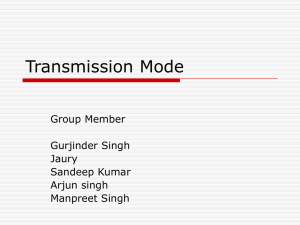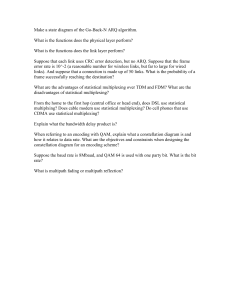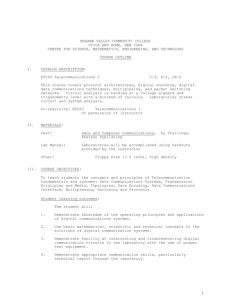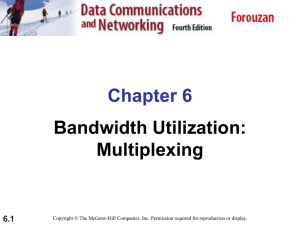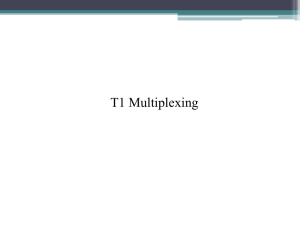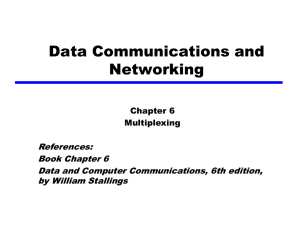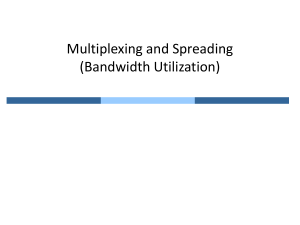Ch8
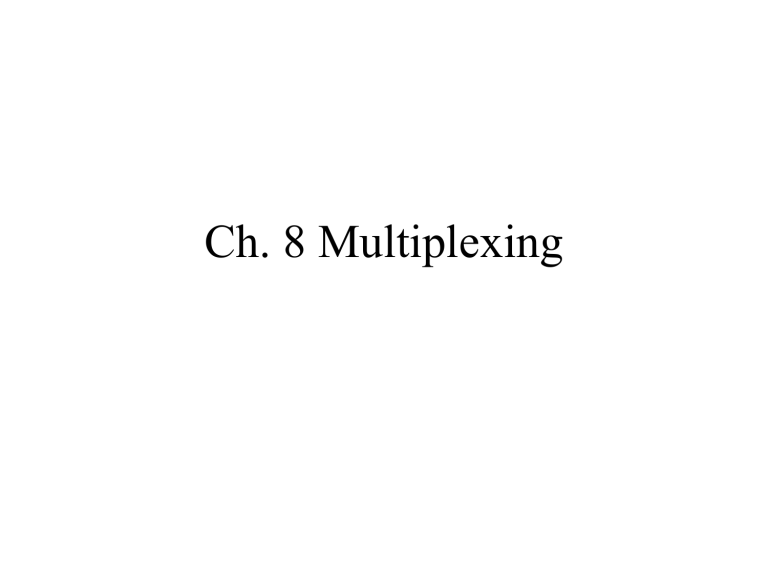
Ch. 8 Multiplexing
Ch. 8 Multiplexing
• 8.1 Frequency-Division Multiplexing
• 8.2 Synchronous Time-Division
Multiplexing
• 8.3 Cable Modems
• 8.4 Asymmetric Digital Subscriber Line
• 8.5 xDSL
• 8.6 Multiple Channel Access
8.1 Frequency-Division Multiplexing
•
FDM--Definition
– The division of a transmission facility into two or more channels by splitting the frequency band transmitted by the facility into narrower bands , each of which is used to constitute a distinct channel .
8.1 Frequency Division Multiplexing (p.2)
•
FDM-- Figure 8.3
– Incoming signals are each modulated using a different carrier frequency (N sources.)
– The channels are separated by guard bands , which are unused portions of the spectrum .
– The spectrum of the composite signal is shown in Figure 8.3b.
– The receiver consists of bandpass filters and demodulators, centered around each carrier frequency.
8.1Frequency Division Multiplexing (p.3)
•
Examples of FDM
–
Example 8.1Voiceband Signals
• 4 k Hz bandwidth (effective bandwidth 300 to 3400 Hz).
• SSBSC--single sideband, suppressed carrier.
• Use 64k Hz, 68k Hz, and 72k Hz carriers (Fig. 8-5).
8.1 Frequency Division Multiplexing (p.4)
•
Analog Carrier Systems (Table 8.1)
– FDM --earliest carrier system and still is common.
– AT&T (North American Standard)
• Group--12 voice channels
• Supergroup--5 groups (60 voice channels)
• Mastergroup-10 supergroups (600 voice channels)
8.1 Frequency Division Multiplexing (p.5)
• Wavelength Division Multiplexing
– Multiple beams of light are transmitted at different frequencies on the same fiber.
– 1997--Bell Labs demonstrated 100 beams each operating at 10 G bps, for a total data rate of 1 trillion bits per second (1 terabit per sec).
– Commercial systems with 160 and 256 channels are currently available.
– Figure 8.5
8.1 Frequency Division Multiplexing (p.6)
•
Problems with FDM carrier systems:
– Crosstalk and intermodulation noise.
– Must demodulate all signals for switching.
– Inflexible.
8.2 Synchronous Time-Division Multiplexing
•
STDM--Definition
– A method of TDM in which time slots on a shared transmission line are assigned to I/O channels on a fixed , predetermined basis.
– Each channel could carry a bit, byte, or block, depending on implementation.
– In general, start and stop bits are stripped off, if asynchronous terminals are being multiplexed.
– See Fig. 8.6.
8.2 Synchronous Time-Division Multiplexing
•
STDM Link Control
– Blocks of bits are the input sources (eg. HDLC).
– Flow control, error control, etc. will be handled before and after the multiplexers.
– Framing
• There is some framing required.
• Added-digit framing--a single bit is added to each frame; the bits will form a repetitive pattern.
8.2 Synchronous Time-Division Multiplexing
•
Pulse Stuffing
– Suppose that the outgoing data rate of the multiplexer, excluding framing bits, is higher than the sum of the maximum instantaneous incoming rates.
8.2 Synchronous Time-Division
Multiplexing
– Excess capacity is used by stuffing extra dummy bits or “pulses” into each incoming signal until its rate is raised to that of a locallygenerated clock signal.
– Solves problems of synchronization among data sources.
8.2 Synchronous Time-Division Multiplexing
• Example 8.3 --STDM-- (Fig.8.8)
– Digital and Analog Sources
• Source 1 Analog
– 2 kHz bandwidth (16 kbps).
• Source 2 Analog
– 4 kHz bandwidth (32 kbps).
• Source 3 Analog
– 2 kHz bandwidth (16 kbps).
• Sources 4-11: Digital
– Each of the eight sources is a 7200 bps synchronous data stream.
8.2 Synchronous Time-Division Multiplexing
• Example 8.3 --STDM-- (Fig.8.8) (cont.)
–
Analog sources
• Sampled and encoded using 4 bits.
• Gathered into one 16-bit buffer .
• Result is a 64 k bps multiplexed information stream.
• Resulting analog source frame is Source 1 (4 bits),
Source 2 (4 bits), Source 3 (4 bits), Source 2 (4 bits).
–
Digital sources
• Each is increased to 8 k bps using pulse stuffing.
– TDM signal : 64 k bps + 8 x 8 k bps =128 k bps.
8.2 Synchronous Time-Division Multiplexing
•
Digital Carrier Systems
– Standards
• North American and ITU-T are different.
• Table 8.3 (DS-1 through DS-4; Levels 1-5)
8.2 Synchronous Time-Division Multiplexing
•
DS-1 Transmission Format (Fig. 8-9)
–
Frame Structure (193 bits)
• 8 bits/channel
• 24 channels
• 1 framing bit.
–
Data Rate
• 193 bits/frame x 8 k frames/sec =1.544 Mbps.
8.2 Time Division Multiplexing (p.9)
•
DS-1 Transmission Format (Fig. 8-9)(cont.)
–
Voice
• Uses bit robbing .
–
Data
– Every sixth frame has one bit "robbed" for control signaling from each channel.
• Bit 8 is used for control signaling (8,000 bps.)
• Bit 1-7 used for 56 kbps service.
• Bit 2-7 used for 9.6, 4.8, and 2.4 kbps service.
8.2 Synchronous Time-Division Multiplexing
•
SONET/SDH
– An optical transmission interface.
– Signal Hierarchy--Table 8.4.
– Frame Formats--Fig.8.10 and 8.11.
8.3 Cable Modem
• A device that allows the user to access the
Internet and other online services through a cable TV network.
– Spectrum Division in North America
• User-to-network data (upstream): 5-40MHz
• Television Delivery (downstream): 50-550 Mz
• Network to user data (downstream: 550-750Mz
8.4 Asymmetric Digital Subscriber Line
• ADSL Design (Fig. 8.14)
– ADSL provides more capacity down-stream than upstream.
– Although originally conceived for video-ondemand, it is being used for Internet access.
– Lowest 25kHz are reserved for voice (POTS)
– Separate Upstream and Downstream (FDM).
– Overlapping Upstream and Downstream (FDM with echo cancellation.)
– Discrete Multitone Transmission (
DMT ) is used.
8.5 xDSL
• ADSL is one of several schemes for highspeed transmission on a subscriber line.
• Other schemes are summarized in Table 8.8
–
H igh Data Rate D igital S ubscriber L ine
– S ingle Line D igital S ubscriber L ine
–
V ery High Data Rate D igital S ubscriber L ine
8.6 Multiple Channel Access
• Frequency Division Duplex
– Two stations have a full duplex connection; each station transmits in a different band.
• Time Division Duplex
– Time compression multiplexing; data is transmitted in one direction at a time.
8.6 Multiple Channel Access
• Frequency Division Multiple Access— spectrum is shared among multiple stations.
– A base station can communicate with a group of stations.
– Satellite networks, cellular networks, WiFi, and
WiMAX.
– Figure 8.19(a)
8.6 Multiple Channel Access
• TDMA—time division multiple access
– Usually used with a base station, also.
– Each sub-channel is dedicated and not shared.
– See Fig. 8.19(b)
